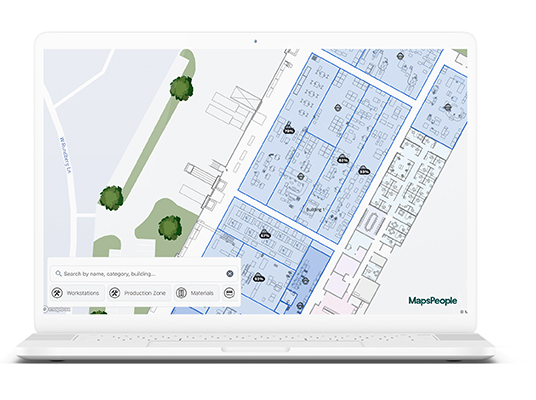Explore the shift from traditional to smart manufacturing: digital solutions, like indoor mapping technology, transform the industry.
By Morten Brøgger, CEO of MapsPeople
Similar to smart buildings, manufacturing plants have come a long way from the past’s outdated security systems and asset management tools. The days of manual spreadsheets and paper files have moved aside to usher in a new era of digital solutions that save time, effort and resources.
Integrating new technologies like indoor mapping and asset management detection software into their existing systems allows manufacturing entities to create a more connected ecosystem where all data points converge into one cohesive location.
By strategically implementing these technologies, manufacturing plants gain the ability to visualize their spatial layouts in intricate detail and dynamically monitor, analyze and optimize the utilization of critical resources.
Traditional manufacturing plants use outdated security systems and old-fashioned asset management tools. Legacy security systems introduce risks because of features that come up short, such as error-prone manual monitoring providing limited coverage, resulting in slow response times and high rates of false alarms.
On the other hand, modern surveillance and detection systems come equipped with AI-powered video monitoring, giving a 360-degree view of the space, allowing for real-time alerts and fewer false alarms.
Similarly, antiquated asset management tools are rife with time-consuming, error-prone processes stemming from manual tracking and physical paper records. Newer, sophisticated digital solutions can automate tracking and give real-time updates based on data. That data can also be used for predictive analytics that forecast future outcomes and improve asset management efficiency and accuracy.
Smarter plants will generate more data to analyze, resulting in more accurate and precise outcomes. Investing in smart technologies decreases operational risks and costs and enables manufacturers to automate tasks, streamline processes and make better decisions. According to a recent survey of over 1,350 manufacturers worldwide, respondents named data analytics as their number one strategy for driving positive business outcomes.

Indoor mapping technology also offers manufacturing plants a proven ROI and clear benefits. These maps create digital representations of indoor spaces applicable to various manufacturing plant use cases, including navigation and wayfinding, asset tracking and space optimization. Through intricate, detailed views of the plant, leaders can better understand how space is currently being used, and facility managers can identify areas of opportunity for spatial optimization, leading to significant cost savings and improved operational efficiency.
Further enhancements in operational efficiency brought about by indoor maps include enhanced safety measures. For example, determining potential hazards and congestion points enables leaders to mitigate risks, reducing the potential for accidents and injuries. In an emergency, indoor maps identify evacuation routes and emergency exits and locate personnel and assets, ensuring the safety of everyone in the plant and facilitating a faster, more effective response.
Advanced asset management detection software tracks inventory and assets throughout the facility through sensors and other technologies to detect and monitor the status of assets in real-time. The software can reduce the time it takes to find and retrieve materials and quickly reveal areas where inventory is overstocked or understocked.
Regarding assets like equipment and machinery, the software can improve maintenance planning and scheduling and help discern when assets are nearing the end of their useful life. This software can integrate with an indoor mapping platform to centralize previously siloed applications and help streamline operations.
Asset management software works through the collection, transmission and analysis of data based on the condition of the assets. When it detects problems or inefficiencies, the software alerts relevant personnel so they can quickly respond to the issue. The real-time monitoring, analysis and optimization of critical resources has essential benefits including:
The time for manufacturing plants to embrace technology is now. From ensuring safety and protecting valuable assets to streamlining systems, adopting tech tools that facilitate these processes is critical to future-proofing manufacturing facilities to ensure long-term sustainability, efficiency and business success.

About the Author
Morten Brøgger has many years of leadership experience from multiple prominent SaaS businesses, including Wire, Huddle, and the globally leading Mobile Roaming Clearing company, MACH. Morten’s positions in international companies reflect several years he has spent in Switzerland, Luxembourg, and in recent years, the USA. As CEO of MapsPeople, he returns to a top position in a Danish-based company where he is the head of the market-leading provider of indoor mapping.
Scott Ellyson, CEO of East West Manufacturing, brings decades of global manufacturing and supply chain leadership to the conversation. In this episode, he shares practical insights on scaling operations, navigating complexity, and building resilient manufacturing networks in an increasingly connected world.